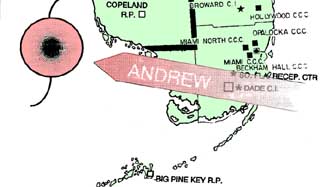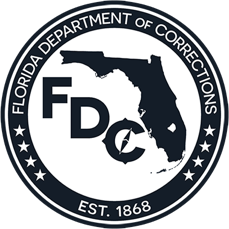1992
OFFENDER POPULATION JUNE 30, 1992
INMATES: 44,508
SUPERVISED: 111,086
INMATES: 44,508
SUPERVISED: 111,086
Prison population reaches 47,012. Columbia Correctional Institution (Lake City, FL) and Gulf Correctional Institution (Wewahitchka, FL) open. The Gainesville and Brooksville Drug Treatment Centers open to accommodate this new type of offender in the system.
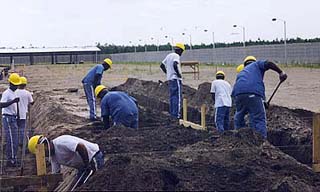
Inmates building Columbia C.I. Annex. Inmate construction crews saved taxpayers money.
The department enters a new phase in computer data collection and transfer with the implementation of the Computer Assisted Reception Process (CARP) system. This system is designed to collect reception-processing data, using a minicomputer system, at each of the reception centers and communicate that data to the mainframe computer. Its goal is to shorten the reception process and eliminate duplication of paperwork. All five reception centers are currently using the CARP system, which allows around-the-clock processing. Tweaking the system has resulted in two-way communication between the local processors and the mainframe, which saves an enormous amount of time.
On July 7, 1992, Title 33 Florida Administrative Code was changed, allowing Correctional Probation Officers the option of carrying firearms.
Court Ordered Payment System (COPS) is established by Probation and Parole Services. This statewide system automates the collection and distribution of all court ordered payments (including monthly payment schedules, disperses payments to payees, calculates surcharges and balances). Training is provided to over 3,000 employees.

Computers now print the cost of supervision receipts. Formerly, these receipts were done manually.
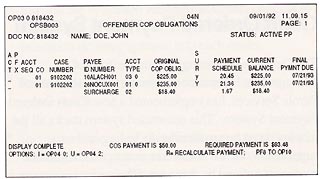
Example of the computerized receipt. It provides a record of both cost of supervision and restitution collected.
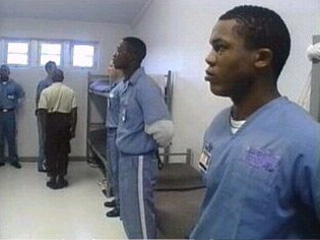
Inmates during inspection
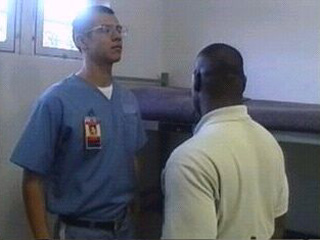
Inspection during extended day programs for youthful offenders.
Hurricane Andrew, a category 4 hurricane, crosses south Florida leaving a wake of destruction. Click for larger view.
The following article was printed in the September/October 1992 Correctional Compass employee newsletter. It details the recovery activities of the Department of Corrections following the impact of Hurricane Andrew on August 24, 1992.
AFTER ANDREW: DAMAGES TALLIED
MONDAY, Aug 24--The morning was extremely quiet at Central Office while everyone waited to hear that staff and inmates were safe. Marta Villacorta, warden at SFRC, was the first one to call in. She reported that staff was safe at the institution but they lost the trailers, had leaking roofs, and other damage. She had spoken to Joe Butler, warden at Broward CI and Willie Floyd, warden at Dade CI, throughout part of the night but contact had been broken about 5:00 a.m.
The initial relief was exhilarating. Many believed that if South Florida Reception Center came through the storm with minimal damage, then Broward and Dade certainly must have done as well. Shortly after noontime word came from Hendry and Charlotte that they had survived well and had no major damage. Joe Butler was next in contact and reported that everyone at Broward CI was okay. There was damage to the trailer park but the overall report was good.
The day dragged on into afternoon and still no contact from Dade CI. By 4:00 p.m., the concern for the staff at Dade CI was beginning to escalate to fear for those who had remained. The Assistant Secretary for Operations attempted to find anyone who would fly over the institution and see if they could determine the status. Broward CI had sent an officer hours earlier to try to get to the institution and still had not received any report back.
About 5:00 p.m. Willie Floyd called Joe Butler to advise him that Dade CI had not fared as well as the other institutions. His staff was safe but they had been hit hard by the storm and the staff housing unit was demolished. The institution had suffered tremendous damage and he did not know the status of the work camp.
Glades CI had damage from fallen trees. Big Pine Key Road Prison reported no damage. Loxahatchee Road Prison had roof damage, window coverings were blown off and the visiting park was damaged by trees. Hollywood CCC reported roof damage; the satellite dish snapped in half; a tree crashed on the visitor's gazebo; gutters were torn from the roof; three windows were blown out in the laundry room; three exit doors were shattered and blown away; and rooms were leaking water.
Miami work release center, Lake Osbourne, West Palm Beach and Ft. Pierce community facilities reported no damage. Pompano work release center had five trees fall on that facility. Shingles were missing from the roof and the dining room leaked. Opa Locka had similar damages and the wooden fence was uprooted. Hendry CI had roofs blown off trailers. Farther north, Martin CI had no damage.
Power was out in Probation and Parole Circuits 16 and 17. Circuits 15 and 19 had no damage. Circuit 11 had no electricity at most offices and minor roof leakage at many offices. The South Miami office sustained significant damage. There was major roof and window damage causing serious water damage. The area was unsafe due to debris and downed power lines surrounding the office. Joyce Haley and the probation and parole staff in Region IV contacted as many employees as they could but it was impossible to make telephone contact with most of them due to the county-wide power failures.
TUESDAY, Aug. 25--Secretary Singletary was able to fly into the area and arrange for transportation to Dade CI and SFRC. He and several staff members arrived to a scene of massive destruction. The total devastation was apparent all along the route to Dade CI and the impact was overwhelming. Secretary Singletary was able to get to the institution to meet with the staff and to survey the damage.
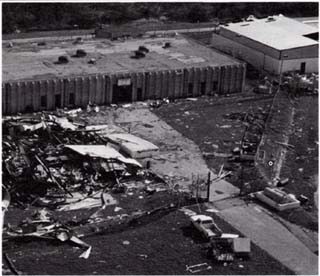
Hurricane Andrew damaged or destroyed most of Dade C.I. and Dade Work Camp.

Near the entrance to Dade C.I., a perimeter fence lies flattened by the 160-mph winds of Hurricane Andrew.

An overturned bus at the rear gate of Dade C.I. demonstrates the power of hurricane winds - even heavy vehicles were damaged.
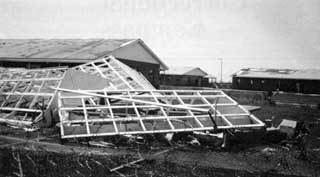
Shattered remains of the visiting park lie in front of damaged dorms at Dade Work Camp.
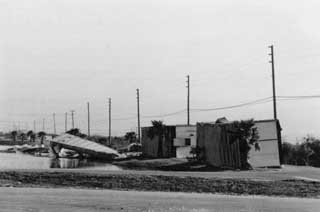
Mobile homes were blown off their foundations along the lake at South Florida Reception Center (SFRC).
Initial calls to the Central Office indicated an immediate need for water, ice and food supplies for staff in the south Dade area. Additionally, assistance was needed to cover roofs, secure files in probation and parole, and establish a plan for clean-up and reconstruction of the damaged buildings.
WEDNESDAY, Aug. 26--Statewide calls were being received offering assistance and donations to the staff victims. Messages were sent out that the department would initiate a fund for distribution in Region IV for those who had lost their homes and property. Each region established a contact person to accept donations and coordinate the delivery of non-perishable foods, clothes, furniture and money.
Statewide donations began to accumulate. Thousands of dollars had already been collected. The Secretary and the staff members who had traveled with him were each making calls to arrange for recovery efforts. Water trucks, refrigeration trucks, supplies, etc., were difficult to locate. The state of Georgia was contacted and they agreed to send a refrigeration truck which would be met at the Georgia/Florida line and driven by FDC staff to south Florida.
Mobile homes were located and contract negotiations on delivery and set-up began in an effort to provide housing as quickly as possible.
THURSDAY, Aug. 27--Help did begin arriving. Water and ice were being delivered and the first trucks with non-perishable food products arrived.
Prison Rehabilitative Industries and Diversified Enterprises (PRIDE) allowed the Department the use of all trucks to make deliveries and worked with staff to coordinate the trips.
South Carolina volunteered assistance. Georgia also offered additional assistance. We received calls from Alabama and Connecticut.
Martin CI, Region IV community facilities, probation and parole office and the regional office were all established as distribution points for the donations.
FRIDAY, Aug. 28--SFRC ingeniously rigged a shower system utilizing a fire hose so that inmates could be showered. It was very successful and from all reports, had a tremendous impact on morale. It signaled the first step in the road to recovery.
Recovery Effort
The relief effort became multi-faceted. A 1-800-HOTLINE began operation to provide assistance. It was advertised through local radio and television as well as through internal operations via DC-Mail. It was used as the initial reception point for incoming calls regarding staff needs such as food, water, ice, basic first aid, clothing, housing, transportation, minor building supplies, property storage and psychological counseling services. Probation and Parole offices, community facilities and major institutions in Region IV all became distribution sites and shelter sites. Staff provided transportation for those who needed supplies or shelter. An estimated 200 FDC employees have received supplies as needed.
Temporary housing has been provided for employees who became homeless or whose residence became uninhabitable due to the storm's destruction. Several staff members who had extra bedrooms offered shelter. Twelve staff members were placed at Humana Hospital in single, private rooms. Thirteen placements were at the Inverrary Hotel. Four placements were made at the Penguin Motel. As of Friday, September 4, contact had been made with every FDC employee.
The average percentage of sentence served by inmates released as of June 30 is 34.0%.
- 1821-1845
- 1868-1876
- 1877-1895
- 1900-1919
- 1921
- 1922-1924
- 1927
- 1928-1931
- 1932 | CHAPMAN
- 1933-1935
- 1936-1939
- 1940-1945
- 1946-1949
- 1950-1955
- 1956-1961
- 1962 | WAINWRIGHT
- 1963-1965
- 1966-1969
- 1970-1975
- 1976-1979
- 1980-1986
- 1987 | DUGGER
- 1988-1990
- 1991 | SINGLETARY
- 1992-1995
- 1996-1998
- 1999 | MOORE
- 2000-2002
- 2003 | CROSBY
- 2004-2005
- 2006 | MCDONOUGH
- 2007
- 2008 | MCNEIL
- 2009-2010
- 2011 | BUSS
- 2011 | TUCKER
- 2012 | CREWS
- 2013-2014
- 2014 | JONES
- 2015-2018
- 2019 | INCH
- 2020-2021
- 2021 | DIXON
- 2022-Today
- Population Summary Table

